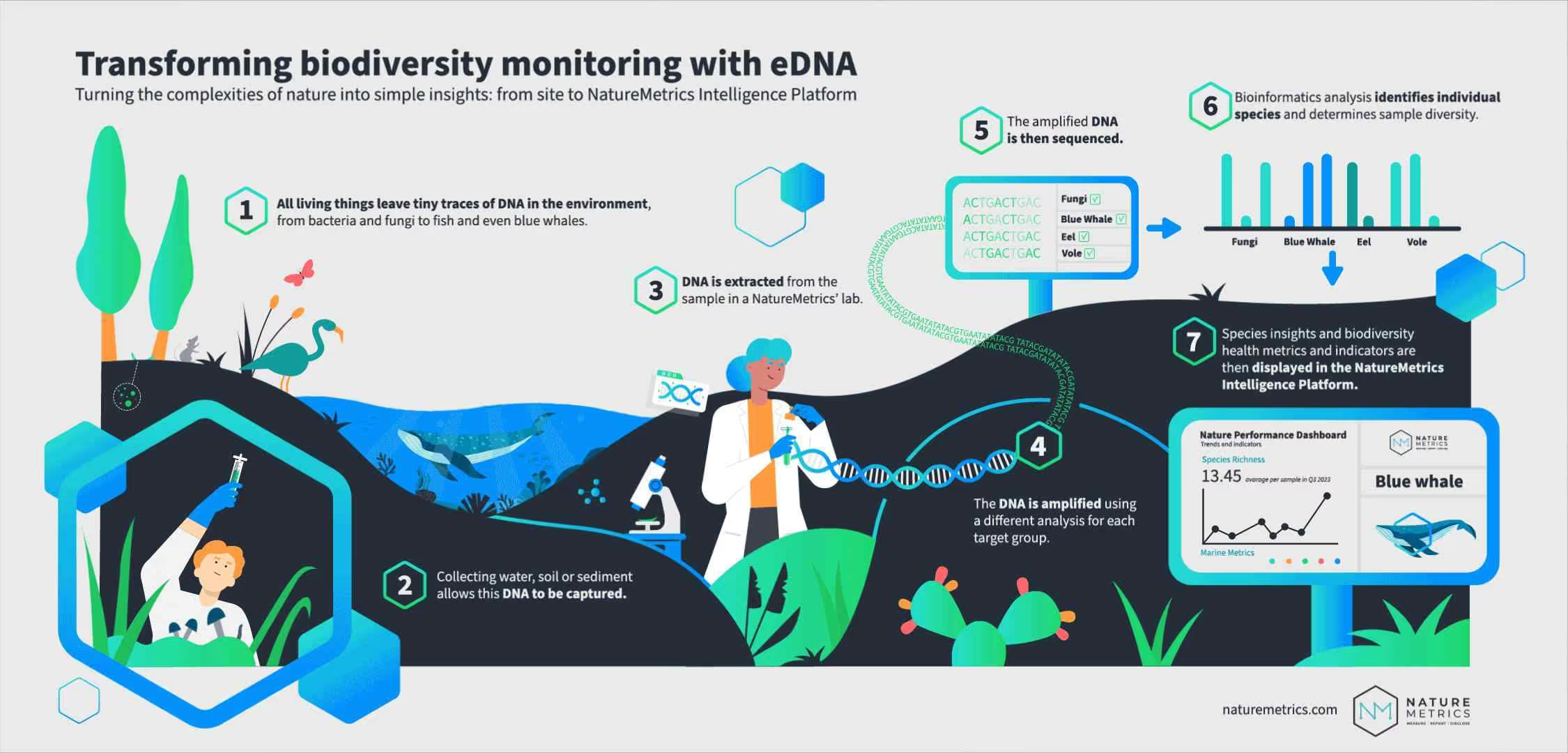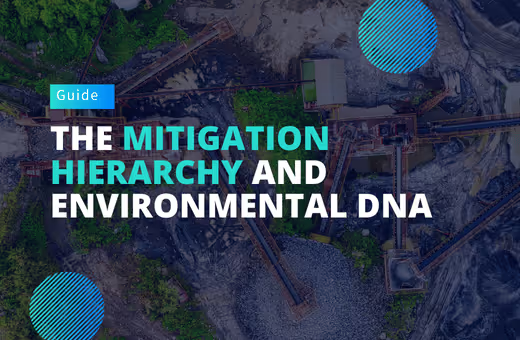Imagine stepping into a dense forest, a vibrant coral reef, or even an expansive desert and being able to unveil the creatures that have lived and passed through there—a story told not by visible signs, but by collecting tiny traces of soil and water. This is environmental DNA (eDNA), a powerful tool revolutionizing the way we understand and conserve our planet's biodiversity.
What is Environmental DNA (eDNA)?
eDNA refers to the genetic material shed by organisms into their environment. This can include cells, tissues, or waste products left in soil, water, and air. Whether it's a strand of fur caught on a branch, a fragment of skin drifting through the water, or even the ancient bones buried in sediment, each tells a part of the ecosystem's saga. The significance of eDNA lies in its ability to provide a sneak peek into the presence and activity of organisms without needing to see or capture them directly.
How Does eDNA Work?
At its core, eDNA analysis is based on the detection and identification of genetic material collected from the environment. Scientists employ molecular techniques to pinpoint the unique DNA sequences that correspond to different species. Sampling for eDNA is a meticulous process; water samples are collected from rivers or oceans, soil samples are gathered from various landscapes, and specialized filters capture airborne DNA.
Once these samples are brought back to the laboratory, eDNA is carefully extracted. Various methods, including polymerase chain reaction (PCR), are used to amplify the DNA fragments, rendering even the smallest traces identifiable. Next, scientists sequence these fragments to match them with known genetic libraries that reveal the species' identity.
How is eDNA collected?
Water Sampling
The most common way of collecting eDNA is water sampling. Water bodies serve as a rich repository of genetic clues. Life in aquatic environments constantly sheds DNA through skin cells, scales, hair, faeces, and other means, which then disperses throughout the water. Scientists collect water samples using bottles or pumps, after which the water is filtered to concentrate the DNA onto filters.
Excitingly, aquatic eDNA collection is becoming increasingly automated. MSC Foundation, the charitable arm of MSC Cruises, has worked with NatureMetrics to develop a system for sampling water used to cool their engine. This has enabled them to collect huge volumes of data across their cruise ship routes.
Meanwhile, Dartmouth Ocean Technologies (DOT) has developed a remotely autonomous vehicle for collecting eDNA samples. It will be used to support the commissioning and decommissioning of various coastal and offshore work sites and monitor the environment for specific organisms of interest, e.g. harmful algae and indicator species.
Soil and Sediment Sampling
In terrestrial ecosystems, soil and sediment hold genetic material from an array of sources — plants, animals, fungi, bacteria, and microorganisms. Collecting eDNA involves sampling the soil or sediment and extracting the DNA from the particulate matter. This method can reveal not only the hidden diversity of plants, animals, fungi, and microorganisms but also provide insights into ecological dynamics and soil health.
Marine sediments are another repository of genetic material, capturing the DNA of organisms that inhabit the water column above, including pelagic and benthic species. Sediment sampling involves collecting cores or grab samples from the ocean floor, which can range from coastal shallows to the deep sea.
Air Sampling
A novel but developing arena for eDNA collection is the use of air. Every breath of air contains bits of eDNA, originating from the skin, fur, feathers, pollen, and spores of various organisms. This DNA can be captured as air passes through air filters. Though challenging due to the lower concentration of DNA compared to water and soil, advancements in air sampling techniques and DNA analysis are rapidly opening new frontiers in aerial eDNA studies.
Invertebrate Sampling
An effective method for surveying invertebrate species in terrestrial environments involves the use of pitfall traps. Traditionally, experienced entomologists would then identify the species caught in the traps using visual and morphological identification methods. However, eDNA can be used to speed up and complement these methods.
The eDNA from pitfall trap samples can be extracted by processing the preservative fluid and any particulate matter within. This genetic material is then analyzed using molecular techniques, such as polymerase chain reaction (PCR), to identify the species present in the sampled area. This approach is particularly useful for detecting rare or elusive species, contributing to a comprehensive understanding of ecosystem structure and biodiversity.
Selected Applications of eDNA
Monitoring invasive species
Some invasive species, such as the zebra mussel and signal crayfish, are notorious for their ability to rapidly colonize new environments, often outcompeting native species and disrupting local ecosystems. Traditional methods of monitoring these organisms can be labor-intensive, costly, and sometimes inefficient, particularly if the invasive species are elusive or at low density. eDNA overcomes these challenges by offering a method to:
Detect Early Invasion: eDNA can reveal the presence of invasive species at the early stages of colonization when their populations are still low and potentially controllable.
Monitor Spread: By regularly sampling different sites, conservationists can track the spread of invasive species, helping predict and inform strategies to prevent further expansion.
Evaluate Management Actions: Regular eDNA surveying can help assess the effectiveness of control measures and management actions, ensuring that the invasive species has been removed or its population is under control.
Monitoring endangered species
For similar reasons, eDNA is also highly effective for tracking endangered and indicator species. Conservation efforts often hinge on accurate data about species locations and abundance, yet collecting this data using traditional methods is challenging. eDNA offers several benefits:
Non-invasive Sampling: eDNA collection does not require physical interaction with animals, minimizing stress and potential harm to sensitive species.
Cost-effective Surveys: By covering larger areas with fewer resources and less time, eDNA becomes a cost-effective means of surveying rare species.
Compliment traditional management: Understanding where endangered species are - are not - can help conservation groups effectively prioritise actions and allocate limited funds optimally.
Citizen-science: Because collecting eDNA samples is so easy, local communities can be effectively mobilised to increase the scope and scale of surveying.
Development ecosystem and biodiversity metrics
One of eDNA's greatest strengths vs. other surveying methods is its scaleability and repeatability. The consistency of data generated using eDNA monitoring makes it well suited to developing broader metrics, which are often more actionable and valuable to organisations and professionals. Types of metrics can include
Biodiversity Inventory and Richness
Species Richness: eDNA can be used to detect a wide array of species within an ecosystem efficiently. By identifying the number of different species through their unique genetic signatures, researchers can develop species richness metrics, which are fundamental indicators of biodiversity.
Community Composition: eDNA surveys capture the various species present in a habitat, thus allowing scientists to construct a detailed picture of the community composition. These data can be used to evaluate the balance of an ecosystem, the presence of keystone species, and the prevalence of native versus non-native species.
Marine Community Health
eDNA data can be used to understand how well a marine community is functioning, which is valuable to fishery managers and local communities alike. These metrics can include:
Food chain integrity: The presence of higher trophic species can infer food chain completeness, which could be used to reveal whether protected areas are providing a safe space for complete food chains to thrive.
Fish commercial value: The economic value of fish species detected in your samples reveals high-priority areas for conservation efforts to protect species of high commercial value.
Prevalence of sensitive species: The prevalence of sensitive species is a proxy for reduces human pressures.
Ecosystem Function and Health
Marine sediment pollution index: Invertebrate communities can be used to monitor water pollution levels and recovery post-events
Soil restoration: Soil health - and efforts to increase that health - can be tracked by understanding the functional roles of bacteria and fungi detected in eDNA surveys
If you would like to find out how eDNA and eDNA-powered metrics can support your business, please get in touch.













.avif)

